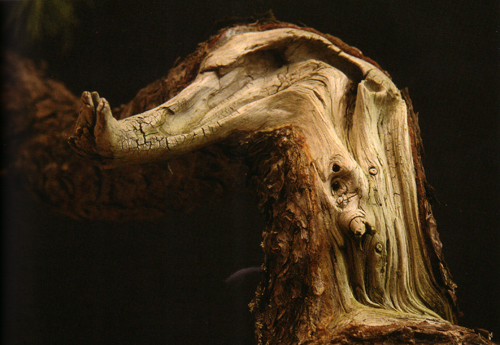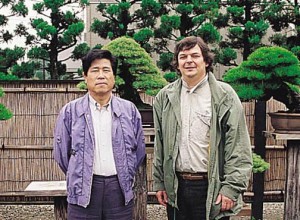
A detail of a Mugo pine (Pinus mugo, also called Swiss mountain pine) that was carved by François Jeker eight years before the photo was taken. François’ expert carving, and the sun, rain, wind and frost have combined to create a natural look and feel. The photo is from Bonsai Today issue 104 (out of print).
François Jeker
Though I’ve never met him and have only seen photos of him working and the results (like the one above), I suspect that François Jeker is one of the foremost experts, if not THE foremost expert, on deadwood in the West. If you’d like some evidence, check out Bonsai Today issues 103, 104 & 105 (103 & 104 are out of print, but don’t despair, we’ll run François’ articles right here as part of our deadwood series).
A little teaser
Here’s a little teaser from François’ book, Bonsai Aethetics, to get you started thinking about deadwood (if you haven’t already started). “According to the hardness of the wood, each species of tree will have a different deadwood. Wood of average hardness will result in a hollow trunk. Hard wood will result in a hollow trunk and large jinned branches. Very hard wood will result in a hollow or deadwood trunk and jinned branches, including even the most slender ones.” Obviously, François has lot more to say on the subject, but maybe that’s enough to whet your appetite.

A detailed view of a spruce trunk collected at a high altitude. From François Jeker’s Bonsai Aesthetics, volume 1.

François and the Master of masters, Masahiko Kimura. This photo appears on François’ website, and a cropped version appears in Bonsai Aesthetics.
Here‘s our previous post on deadwood.
A few remarks:
1. Of course Winter is the ideal time to do the detailed carving. You have more time because of lack of active growth.
2. Creation of natural-looking deadwood takes many years. Each year (and I sometimes skip years) you look at what’s happening and work on the wood.
3. It is inevitable that you will have to work on some kind of dead-wood even with smaller material, but using collected trees forces your hand! Learn how to do it.
4. Working on evergreens like Olea is a problem, because you must be able to reach the area of dead-wood and this may be in a position where new growth is in your way. Do the initial carving extremely quickly (around 12 – 18 months after the budding, after collecting, so that you can work without leaves and branches that impede your access to the wood!
5. I am a dentist and let me tell you that we have very nice bits that fit dremels!! Ask your dentist or his/her dental technician!
Thanks for the tips Pieter,
Are you saying that dental dremel bits are unique and can’t be found at your hardware store?